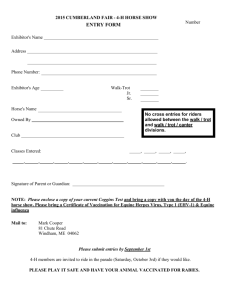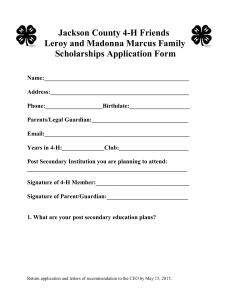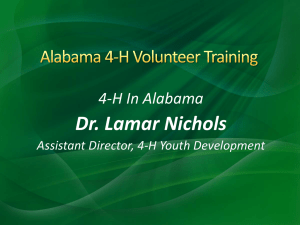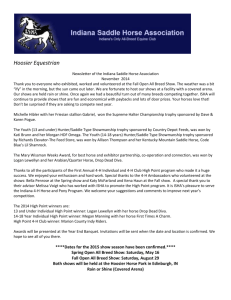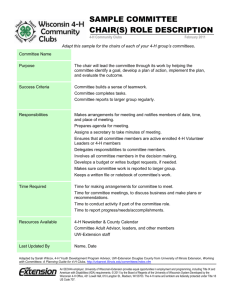How to Get Started in a 4-H Horse Project Written by: Sally Barney
advertisement
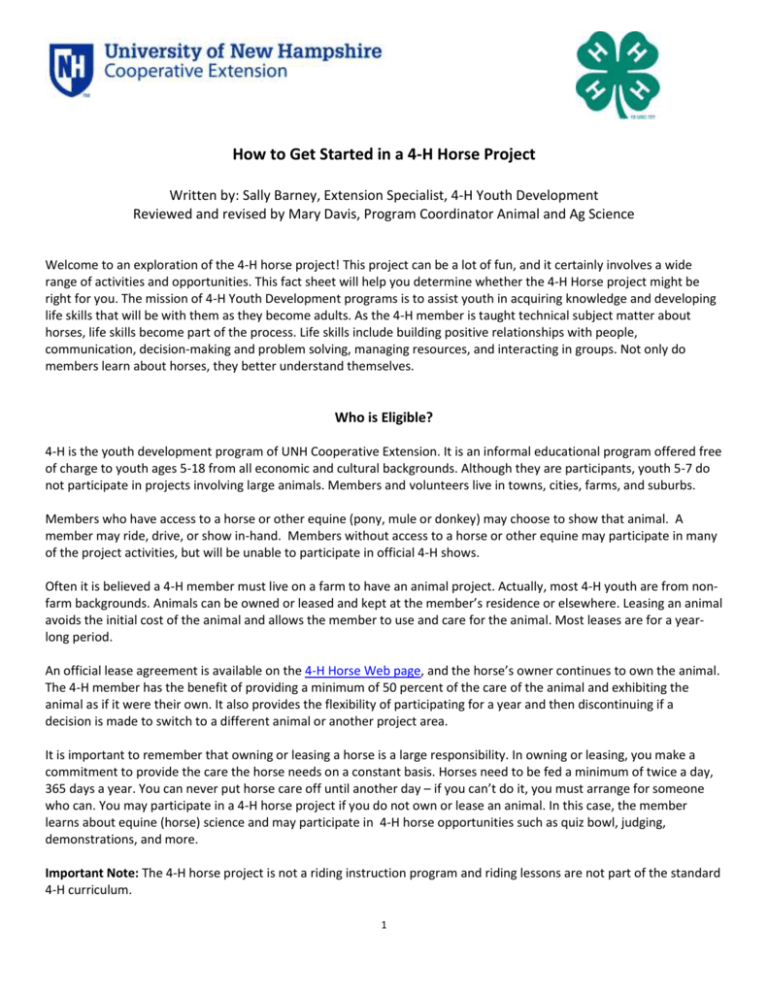
How to Get Started in a 4-H Horse Project Written by: Sally Barney, Extension Specialist, 4-H Youth Development Reviewed and revised by Mary Davis, Program Coordinator Animal and Ag Science Welcome to an exploration of the 4-H horse project! This project can be a lot of fun, and it certainly involves a wide range of activities and opportunities. This fact sheet will help you determine whether the 4-H Horse project might be right for you. The mission of 4-H Youth Development programs is to assist youth in acquiring knowledge and developing life skills that will be with them as they become adults. As the 4-H member is taught technical subject matter about horses, life skills become part of the process. Life skills include building positive relationships with people, communication, decision-making and problem solving, managing resources, and interacting in groups. Not only do members learn about horses, they better understand themselves. Who is Eligible? 4-H is the youth development program of UNH Cooperative Extension. It is an informal educational program offered free of charge to youth ages 5-18 from all economic and cultural backgrounds. Although they are participants, youth 5-7 do not participate in projects involving large animals. Members and volunteers live in towns, cities, farms, and suburbs. Members who have access to a horse or other equine (pony, mule or donkey) may choose to show that animal. A member may ride, drive, or show in-hand. Members without access to a horse or other equine may participate in many of the project activities, but will be unable to participate in official 4-H shows. Often it is believed a 4-H member must live on a farm to have an animal project. Actually, most 4-H youth are from nonfarm backgrounds. Animals can be owned or leased and kept at the member’s residence or elsewhere. Leasing an animal avoids the initial cost of the animal and allows the member to use and care for the animal. Most leases are for a yearlong period. An official lease agreement is available on the 4-H Horse Web page, and the horse’s owner continues to own the animal. The 4-H member has the benefit of providing a minimum of 50 percent of the care of the animal and exhibiting the animal as if it were their own. It also provides the flexibility of participating for a year and then discontinuing if a decision is made to switch to a different animal or another project area. It is important to remember that owning or leasing a horse is a large responsibility. In owning or leasing, you make a commitment to provide the care the horse needs on a constant basis. Horses need to be fed a minimum of twice a day, 365 days a year. You can never put horse care off until another day – if you can’t do it, you must arrange for someone who can. You may participate in a 4-H horse project if you do not own or lease an animal. In this case, the member learns about equine (horse) science and may participate in 4-H horse opportunities such as quiz bowl, judging, demonstrations, and more. Important Note: The 4-H horse project is not a riding instruction program and riding lessons are not part of the standard 4-H curriculum. 1 How to Start Call the UNH Cooperative Extension office in your county. Talk to your county 4-H Youth Development staff and explain your interests and the town you are from. Within each county there are clubs offered either by town or by project. You might be referred to a county horse club, or to a club that offers a variety of projects. A 4-H member may also carry the project as part of a family club. Family clubs function as a 4-H club but involve one family rather than youth from many families. All members focus on citizenship, leadership and service as well as project goals. The 4-H program emphasizes family involvement. As you think about joining a horse project, the whole family should think about the commitment and time it takes to have a positive experience. Club meetings may occur one or two times per month. There are also special clinics and activities, plus animal ownership and care requires work every day. Parents are encouraged to assist clubs with transportation, supplying refreshments, or serving as chaperones or volunteering in other ways. When Is a Good Time to Start? The 4-H year follows the school year. During summer months, many clubs are less structured and focus more on showing, exhibiting or camping opportunities. Most clubs accept new members in the fall to take advantage of the structured activities held at that time. Contact your county UNH Cooperative Extension office for details on joining 4-H in your county. Some horse shows or classes may be limited to 4-H members only. For a 4-H member to participate in these events they must have their animal owned or leased, and registered via an Intent to Show form with the county 4-H office, prior to May 1. Youth 12 and over who wish to represent New Hampshire in the 4-H show at Eastern States Exposition must have their animals owned or leased and registered via an Intent to Show form with the county 4-H office prior to April 1. In this way, youth are exhibiting the results of their personal project work with their 4-H animal. Providing a base date also allows time for youth to become familiar with the management of their animal and with control of the animal when mounted. 4-H Horse Activities 4-H members in the horse project participate in local club meetings where a lot of information about horses is learned. 4-H members may participate in demonstrations, public speaking, horse judging, horse quiz bowl, hippology, and 4-H horse shows. Participation and practice begin at the club level. As the 4-H member gains skill and confidence, he or she may progress to participation at the county and state levels. There are also 4-H horse events held regionally and nationally, but everything begins in the local club or 4-H unit. What Horse or Horse Sport Should I Choose? Selecting a horse is a matter of personal choice. There are no specific breeds or horse sports recommended for 4-H project animals. Keep in mind stallions are not permitted in 4-H shows; some shows do not permit nursing mares. Draft horses and ponies as well as mules and donkeys are suitable for fitting and showmanship, but their suitability in mounted classes may vary. Many 4-H shows offer driving classes (where the horse pulls a cart) and in-hand classes, where the exhibitor leads the animal. Although the term horse is most often used, a member may use any equine as a project animal, including ponies, miniature horses, donkeys and mules. 2 Basic Facilities All you need to know about horse facilities cannot be described in this small space, but the following provides you with information to get your planning started if you are going to house your horse on your own property: 1. Check the zoning laws to be sure horses are permitted. 2. Provide adequate housing. The area should be clean, dry, and free from drafts, with adequate sunlight and ventilation. A full size horse needs a mini-mum of a 10x10 foot stall and a 10x12 is highly preferred. 3. Allow space for handling feeds and equipment as well as for properly handling manure. Waste disposal is very important and may be regulated by your community 4. Plan for adequate utilities. Horses must have access to water. Electricity will be helpful for lighting, using clippers, etc. 5. Provide an adequate, well fenced exercise area. Equipment to Get Started You will need to purchase or borrow all the items you will need for your project animal. Some items can be obtained second hand. Costs vary widely – you can check local tack stores, catalogs and the internet to get an idea of prices. Here is a list of the basic horse care equipment you will need: Saddle (including “fittings” – girth and stirrups) Bridle Saddle Pad Halter Lead Rope Grooming kit (curry comb, dandy brush, hard brush, mane and tail comb, hoof pick) Buckets (2 water, 1 feed) Stall Cleaning tools First Aid Kit If pursuing an driving or in-hand showing, different or additional equipment will be needed Annual Feed and Care for an average horse Note: Expenses will vary widely based on size and metabolism of animal, access to growing pasture, amount of work performed by the animal, health needs, etc. Hay Grain Hoof care Veterinary Care 175-200 bales per year per horse 3 – 5 50 pound bags per month per horse trim or shoe every 4-8 weeks annual or semi-annual vaccination and dental care; additional if chronic health conditions, illness or accident Bedding 10-20 bags of shavings or bales of straw per month or equivalent bulk bedding Miscellaneous supplements, fly control, dewormer, etc. Additional expenses Entry fees, training fees, riding lessons, etc. There are always unanticipated and incidental costs associated with animal ownership. You can cut your initial investment in tack and equipment by participating in equipment swaps and used tack and clothing sales. Quality used equipment is frequently available. 3 Summary A 4-H horse project is a big commitment, but it pays big dividends. 4-H members who care for animals learn about and practice decision making, responsibility, record keeping, and time management. Youth who take advantage of 4-H opportunities develop good communication skills as well as leadership skills. As you enroll in the project, be sure your whole family is ready for the commitment and has counted the costs. The horse project is more than caring for a horse; it is a project which builds skills that carry through a lifetime. Visit our website: extension.unh.edu UNH Cooperative Extension is an equal opportunity educator and employer. University of New Hampshire, U.S. Department of Agriculture and NH counties cooperating. October 2015 4
